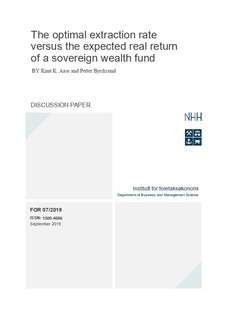| dc.description.abstract | With reference to funds established for the benefits of the public at large, a university endowment, or other similar sovereign wealth fund, we demonstrate that the optimal extraction rate from the fund is significantly smaller than the expected real rate of return on the underlying fund. We consider the situation where the influx to the fund has stopped, it is in a steady state, and is invested broadly in the international financial markets. The optimal spending rate secures that the fund is a perpetuity, i.e., it will last 'forever', where the real value of the fund after payments is stationary, while spending according to the expected rate of return will deplete the fund with probability 1. Optimal portfolio choice and spending are then inconsistent. Our conclusions are contrary to the recommendations of an expert panel to the Norwegian Government Pension Fund Global, as well as at odds with part of the extant literature on the management of endowments of universities. | nb_NO |
